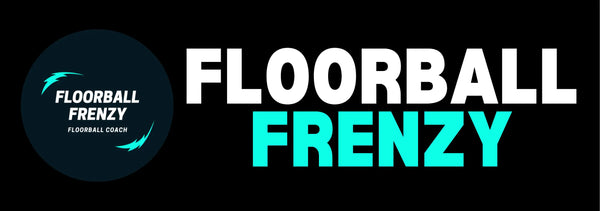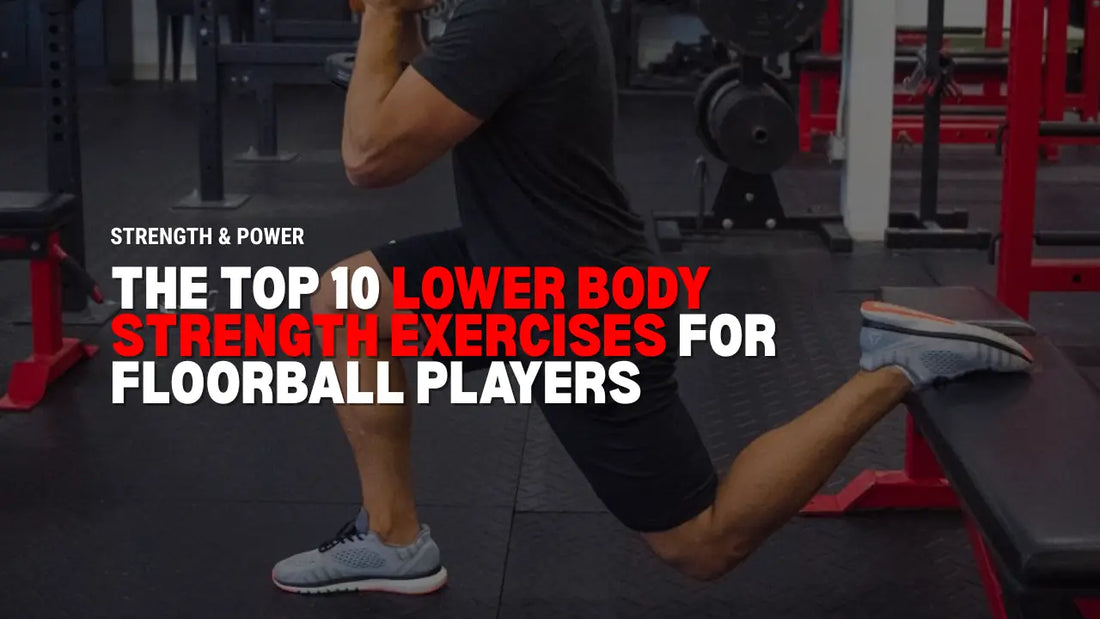The Top 10 Lower Body Strength Exercises for Floorball Players
For floorball players – lower body strength is everything.
Want faster acceleration? Get stronger legs.
Want quicker changes of direction or more agility in tight spaces? Get stronger legs.
Want to be more stable and harder to knock off the ball? Get stronger legs.
While it’s far from being the only piece of the performance puzzle – for nearly every floorball player, building intentional lower body strength is one of the fastest ways to level up your game.
In this article you’re going to learn why lower body strength is so valuable, the types of lower body exercises, and the 10 best exercises to add into your training.
Let’s dive in.
Why Lower Body Strength Is So Essential for Floorball Players
If you’re a floorball player, you’ve probably been told countless times: “train your legs.” We see youth players doing extra squats and lunges, and the pros are no different.
But why is it so important to specifically build strength in your lower body?
Here are three big reasons:
- Strength is the foundation of power. Power = Force ÷ Time. The stronger your legs, the more potential you have for explosive first steps, sprints, and shots. Strength fuels the power that separates average players from explosive ones.
- Strength drives agility and change of direction. Floorball is constant acceleration, deceleration, and re-acceleration. Stronger legs absorb force better and re-direct it faster. Research shows stronger athletes are more efficient and safer in direction changes.
- Strength creates stability. In battles for the ball or when defending low, strength in new ranges of motion and through stabilizer muscles gives you balance, control, and confidence in every movement.
Understanding the Types of Lower Body Exercises
Not all leg exercises are created equal.
We break lower body training into three movement categories:
- Squat-based – up-and-down hip/knee movement (e.g., squats).
- Hinge-based – posterior-chain dominant, hips back-to-front (e.g., deadlifts, hip thrusts).
- Lunge-based – single-leg strength, combining anterior + posterior demands (e.g., lunges, split squats).
Why does this matter? Because floorball players need all three. Many athletes default to their “favorite” pattern, which creates imbalances.
That’s why in FloorballFrenzy training programs, we hit all three categories every workout.
The Best Lower Body Exercises for Floorball Players
Here are the top 10 leg exercises to build strength, speed, and stability for floorball:
- Trap Bar Deadlift
- Reverse Lunge
- Goblet & Front Squat
- Single Leg RDL
- Anterior Loaded Split Squat
- Single Leg Box Step Offs
- Hip Thrust
- Cossack Squats
- Eccentric Hamstring Sliders
- Lawn Bowlers
If you simply integrated these 10 into your routine each week, you’d be ahead of 95% of players.
1) Trap Bar Deadlift
Movement Pattern: Hinge
The Deadlift is one of the single best full-body strength builders. It loads the glutes, hamstrings, and entire posterior chain while also challenging core and grip strength.
Using the trap bar (hex bar) shifts the load into safer and more athletic positions — less stress on the spine, more natural for athletes, and more transferable to explosive movements like sprints.
That’s why this is in nearly every elite program.
2) Goblet Squat
Movement Pattern: Squat
An underrated gem.
The Goblet Squat teaches clean mechanics and full-depth squatting while still allowing you to load heavy. For young players, it’s the perfect starting point. For pros, it’s still valuable for building strength in great positions without barbell stress.
Don’t underestimate heavy goblet squats — they translate directly into stronger, more controlled movement on court.
3) Single Leg RDL
Movement Pattern: Hinge
Few exercises build single-leg stability and posterior chain strength like the Single Leg Romanian Deadlift.
It challenges ankle-knee-hip alignment, glute/hamstring strength, and core bracing — all on one leg, just like when sprinting, cutting, or shooting in floorball.
Start bodyweight. Progress with dumbbells. Focus on control over load.
4) Anterior Loaded Split Squat
Movement Pattern: Lunge/Squat
Like a squat and lunge hybrid, this exercise trains unilateral quad strength while keeping your torso upright.
Holding a dumbbell or kettlebell in the “goblet” position reinforces posture and bracing. Add tempo (slow eccentrics, pauses) for even more benefit.
A must-have in every program.
5) Reverse Lunge
Movement Pattern: Lunge
Our go-to lunge variation.
Unlike forward lunges, the reverse lunge emphasizes glutes and posterior chain activation — mechanics that closely mimic the drive phase of sprinting and accelerating in floorball.
It also reduces knee stress while building balanced, powerful legs.
6) Single Leg Box Step Offs
This simple but brutal exercise targets the quads, especially the VMO (inner quad), while demanding knee alignment and stability.
Why it matters: the VMO is crucial for knee health and absorbing force in sharp stops, cuts, and direction changes.
Start with a low box and progress height before adding weight.
7) Hip Thrust
Movement Pattern: Hinge
Glutes are your engine — and the hip thrust is the best way to build them.
Unlike deadlifts, this isolates and loads the glutes heavily without taxing the entire system. Stronger glutes = faster sprints, stronger shots, and more explosive power.
This is non-negotiable for floorball players.
8) Lawn Bowlers
Movement Pattern: Lunge/Stability
A sleeper pick.
This cross-body single-leg reach trains ankle, knee, hip, and core stability all at once. It forces your entire chain to stabilize, just like in awkward, low, or off-balance positions in floorball.
Slow it down and reach further for max effect.
9) Eccentric Hamstring Sliders
Movement Pattern: Hinge
Hamstrings are often the weak link for athletes.
This exercise isolates eccentric hamstring strength (controlling the lengthening phase) — which research shows is the best predictor of hamstring injury prevention.
Use sliders, towels, or socks on hardwood. Go slow. Build bulletproof hamstrings.
10) Cossack Squats
Movement Pattern: Lunge/Mobility
This hybrid exercise develops strength, mobility, and motor control in lateral positions.
For floorball players, that means better wide stances, sharper cuts, and groin resilience.
Use bodyweight for mobility, light weights for strength, and always emphasize control at the bottom.
In Conclusion
Lower body strength is the foundation of floorball performance.
From explosive first steps to rapid changes of direction to rock-solid stability in duels — it all starts with strong legs.
Gone are the days of doing a few squats and calling it done. These 10 exercises should form the backbone of your program.
Choose a squat, hinge, and lunge variation every session, and you’ll build the integrative strength that transfers directly to the court.
Now get out there & get training — FloorballFrenzy style.
Want a proven system to speed this up?
When you grab any product from FloorballFrenzy.com, you’ll also unlock:
- BONUS: Mobility & Stretching Guide for Floorball – packed with drills to complement your squats, hinges, and lunges.
- BONUS #2: Travel Workouts for Floorball Players – perfect for keeping your lower body strong and mobile on the go.
- BONUS #3: Game-Day Nutrition Blueprint – fuel your legs to stay powerful through all four periods.
These extras were designed to reinforce exactly what you’re building here — strong, mobile legs that dominate the court.

